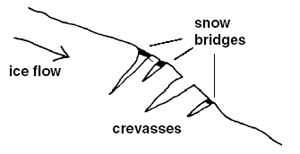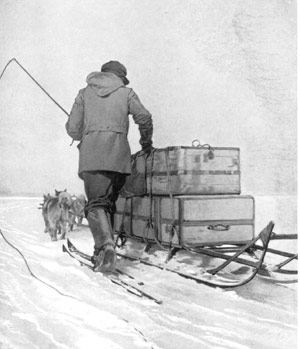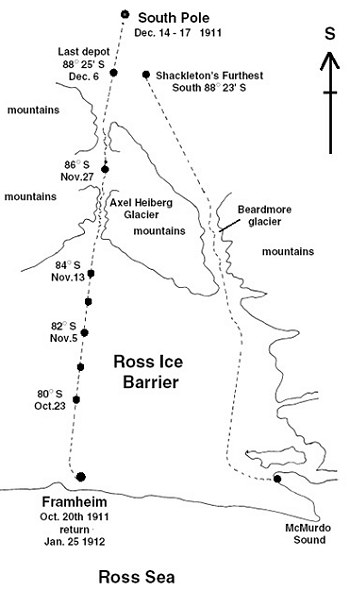
| Glasgow Digital Library | Voyage of the Scotia | BRUCE | PEOPLE | SHIP | ANTARCTIC | INDEX |
|---|
On 19 October 1911 five men, four sledges and 52 dogs left for the South Pole. Beacons of snow were constructed every 13- 15 kilometres. Although progress was good, the men made sure the dogs had adequate rest periods. On 8 November they reached the depot at 83°S and left supplies for four days. Supplies were also left at 84°S and 85°S. The 85°S depot was the last main depot and supplies were left for 30 days. Supplies for 60 days were then taken on the three sledges. Some of the weaker dogs had been killed and eaten by their companions.

The ascent to the plateau had begun. Many detours were needed to avoid the crevasses in this route through the mountains. Crevasses are caused when there is a change of slope of the glacier and are sometimes covered by a thin snow bridge which can collapse causing dogs or men to fall in.

The plan for the attempt on the South Pole required dogs to be killed and eaten when required. The camp at 2,130 metres (7,000 feet) was known as Butcher's Camp because here they killed 24 dogs, leaving 18 dogs (six per sledge). The dead dogs were fed to the other dogs and some of the best meat was kept for the men. Carcases were also taken aboard the sledges. This was a very sad day as each dog handler was responsible for the death of his own dogs.
On 20 November the party reached 3,080 metres (10,920 feet) at 85°36'S. Here they were stormbound for five days in their tents. Altitude sickness was felt until they became acclimatised. On 28 November the log read 'fog, fog and more fog'. Progress was slow but when the weather cleared large mountains were seen sticking through the snow (known as nunataks). Mount Nilsen was a great landmark.
On 4 December, 87°S was passed at a height of 3,100 metres (10,100 feet). Snow gales and poor visibility were to follow. On 30 November they were ascending the glacier, and this was cleared by 1 December. On 6 December they passed Shackleton's furthest south of 88°23'S with great jubilation. 'No other moment of the whole trip affected me like this. The tears forced their way into my eyes,' wrote Amundsen.
The last depot was at 88°25'S. At this time all five men were suffering from frost sores in their faces: 'We looked like the worst type of tramps and ruffians'. Beacons were still being built for marking the return journey.
'Sir Ernest Shackleton's name will always be written in the annals of Antarctic exploration in letters of fire.'
Amundsen

| Glasgow Digital Library | Voyage of the Scotia | BRUCE | PEOPLE | SHIP | ANTARCTIC | INDEX |
|---|